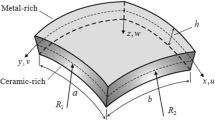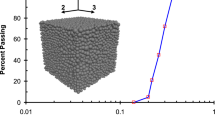Abstract
The strength-dilatancy characteristics of frictional materials embraced in the hypoplastic model proposed by Gudehus and Bauer are investigated and compared with the revised model suggested by Huang. In the latter the deviatoric stress in the model by Gudehus and Bauer is replaced by a transformed stress according to the stress transformation technique proposed by Matsuoka. The flow rule, the failure state surface equation and the strengthdilatancy relationship embraced in both models are derived analytically. The performance of the two hypoplastic models in reproducing the relationship between the peak strength and the corresponding dilation rate under triaxial compression, plane compression and plane shearing are then extensively investigated and compared with experimental results and with the predictions made by particular classical stress-dilatancy theories. Numerical investigations show that the performance in reproducing the strength-dilatancy relationship is quite satisfactory under triaxial compression stress state in both models and the predictions made by the transformed stress based model are closer to the results obtained from classical stress-dilatancy theories for plane compression and plane shearing problems.
Similar content being viewed by others
References
Gudehus G. A comprehensive constitutive equation for granular materials. Soil and Foundation, 1996, 36(1): 1–12
Bauer E. Calibration of a comprehensive hypoplastic model for granular materials. Soil and Foundation, 1996, 36(1): 13–26
Bauer E. Conditions for embedding Casagrande’s critical states into hypoplasticity. Mechanics of Cohesive-Frictional Materials, 2000, 5(2): 125–148
Huang W X, Sloan S, Fityus S. Incorporating a predefined limit condition in a hypoplastic model by means of stress transformation. Mechanics of Materials, 2008, 40(10): 796–802
Matsuoka H, Yao Y P, Sun D A. The cam-clay models modified by the SMP criterion. Soil and Foundation, 1999, 39(1): 81–95
Taylor D W. Fundamentals of Soil Mechanics. New York: John & Wiley, 1948
Schofield A N, Wroth C P. Critical State Soil Mechanics. London: McGraw-Hill, 1968
Rowe P W. The stress dilatancy relation for static equilibrium of an assembly of particles in contact. Proceedings of the Royal Society of London. Series A, Mathematical and Physical Sciences, 1962, 269(1339): 500–527
Bolton M D. The strength and dilatancy of sands. Geotechnique, 1986, 36(1): 65–78
Simoni A, Houlsby G T. The direct shear strength and dilatancy of sand-gravel mixtures. Geotechnical and Geological Engineering, 2006, 24(3): 523–549
Vardoulakis I, Georgopoulos I O. The ‘stress-dilatancy’ hypothesis revisited: shear-banding related instabilities. Soil and Foundation, 2005, 45(2): 61–76
Iai S. A new look at the stress dilatancy relation in Cam-Clay model. Soil and Foundation, 1994, 34(2): 1–12
Cubrinovski M, Ishihara K. Modelling of sand behaviour based on state concept. Soil and Foundation, 1998, 38(3): 115–127
Matsuoka H, Nakai T. Relationship among Tresca, Mises, Mohr-Coulomb and Matsuoka-Nakai failure criteria. Soil and Foundation, 1985, 25(4): 123–128
Huang W X, Sun D A, Sloan S W. Analysis of the failure mode and softening behavior of sands in true triaxial tests. International Journal of Solids and Structures, 2007, 44(5): 1423–1437
Lade P V. Assessment of test data for selection of 3-D failure criterion for sand. International Journal for Numerical and Analytical Methods in Geomechanics, 2006, 30(4): 307–333
Lade P V. Instability, shear banding, and failure in granular materials. International Journal of Solids and Structures, 2002, 39(13–14): 3337–3357
Fu Z Z, Bauer E. Hypoplastic constitutive modeling of the long term behaviour and wetting deformation of weathered granular materials. In: Bauer E, Semprich S, Zenz G eds. In: Proceeding of the 2nd International Conference on Long Term Behaviour of Dams. Graz, 2009, 473–478
Oda M. Deformation mechanism of sand in triaxial compression tests. Soil and Foundation, 1972, 12(4): 45–63
Author information
Authors and Affiliations
Corresponding author
Rights and permissions
About this article
Cite this article
Fu, Z., Liu, S. & Wang, Z. The strength-dilatancy characteristics embraced in hypoplasticity. Front. Struct. Civ. Eng. 7, 178–187 (2013). https://doi.org/10.1007/s11709-013-0191-0
Received:
Accepted:
Published:
Issue Date:
DOI: https://doi.org/10.1007/s11709-013-0191-0




